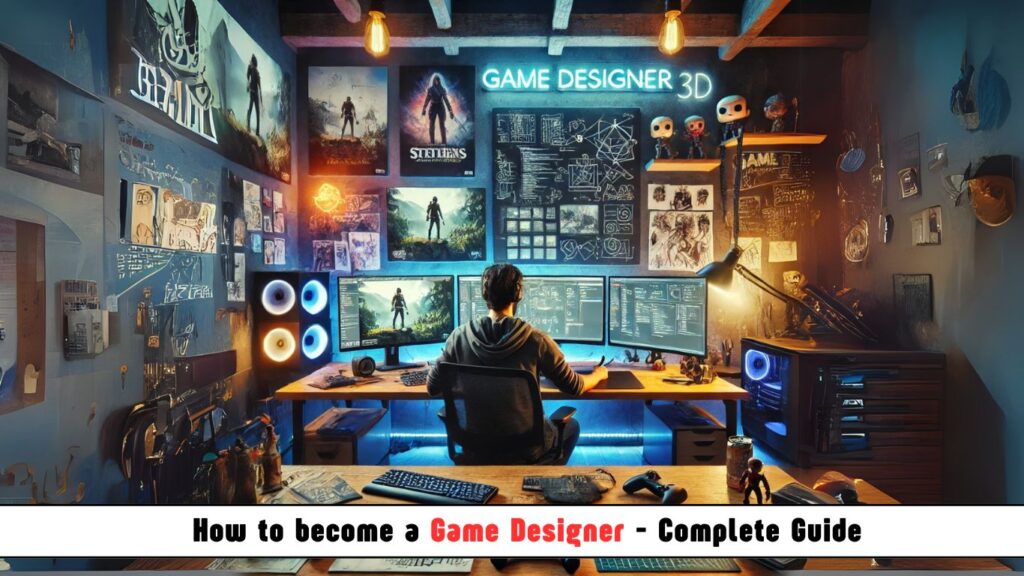
Introduction
Video games have evolved from simple pixelated screens to immersive, multi-billion-dollar experiences. Behind every great game is a Game Designer—the creative and technical mastermind who crafts gameplay, mechanics, and player experiences.
If you’ve ever dreamed of designing the next Fortnite, Minecraft, or Elden Ring, this guide covers everything you need to know—from the history of game design to salary expectations, key responsibilities, and future trends.
1. What is a Game Designer?
A Game Designer is responsible for shaping the core experience of a video game. They design:
- Gameplay mechanics (rules, combat systems, puzzles)
- Levels & worlds (environments, missions, progression)
- Story & characters (narrative, dialogue, quests)
- Player engagement (difficulty curves, rewards, UX)
Game Designers work closely with artists, programmers, and writers to bring their vision to life.
2. The History of Game Design
Game design has evolved alongside technology and culture.
Early Beginnings (1950s-1970s)
- 1958: “Tennis for Two” (First interactive electronic game)
- 1972: Atari & “Pong” (First commercial arcade hit)
- 1978: “Space Invaders” (Popularized scoring & difficulty progression)
The Golden Age (1980s-1990s)
- 1981: “Donkey Kong” (Introduced platforming & storytelling)
- 1985: “Super Mario Bros.” (Defined side-scroller mechanics)
- 1993: “Doom” (Pioneered first-person shooters)
Modern Era (2000s-Present)
- 2004: “World of Warcraft” (Revolutionized MMORPGs)
- 2007: “Portal” (Innovated puzzle mechanics)
- 2011: “Minecraft” (Popularized sandbox creativity)
- 2020s: VR & AI (Next-gen immersion & procedural generation)
Today, game design is a blend of art, science, and psychology.
3. Roles and Responsibilities of a Game Designer
Game design is a broad field with specialized roles:
1. Gameplay Designer
- Designs core mechanics (movement, combat, physics)
- Balances difficulty & progression
2. Level Designer
- Builds environments, maps, and missions
- Ensures player flow & pacing
3. Narrative Designer
- Writes storylines, dialogue, and lore
- Integrates quests & player choices
4. Systems Designer
- Creates economies, stats, and RPG elements
- Optimizes gameplay loops
5. UX/UI Designer
- Designs menus, HUDs, and controls
- Ensures accessibility & player comfort
4. Salary of a Game Designer
Salaries vary by experience, location, and studio size.
Global Salary Breakdown (Annual)
| Country | Entry-Level | Mid-Level (3-5 yrs) | Senior-Level (5+ yrs) |
|---|---|---|---|
| USA | $50K – $70K | $70K – $100K | $100K – $150K+ |
| UK | £25K – £40K | £40K – £60K | £60K – £90K+ |
| India | ₹4L – ₹8L | ₹8L – ₹15L | ₹15L – ₹30L+ |
| Canada | CAD 50K – 70K | CAD 70K – 90K | CAD 90K – 120K+ |
Top-Paying Studios:
- AAA Studios (Rockstar, Naughty Dog, Ubisoft)
- Indie Success Stories (Supergiant Games, Team Cherry)
- Tech Giants (Google, Apple, Meta in AR/VR gaming)
Freelance designers charge $30 – $150/hour for contract work.
5. Qualifications & Skills Needed
A. Educational Background
- Bachelor’s Degree in Game Design, Computer Science, or Art.
- Bootcamps & Certifications:
- Unity Certified Game Designer
- Unreal Engine Training
- Coursera/NYU Game Design Courses
B. Essential Skills
✅ Game Engines (Unity, Unreal, Godot)
✅ Prototyping (Paper designs, rapid digital prototypes)
✅ Scripting (Basic C#, Python, or visual scripting)
✅ Psychology of Play (Player motivation, reward systems)
✅ Collaboration (Working with artists, programmers)
C. Soft Skills
- Creativity & Problem-Solving (Innovating within constraints)
- Adaptability (Industry trends change fast)
6. How to Get Started in Game Design
Step 1: Learn the Fundamentals
- Play critically (Analyze mechanics in your favorite games)
- Study game design theory (Books: “The Art of Game Design” by Jesse Schell)
Step 2: Build a Portfolio
- Create small games (Use Unity/Unreal free versions)
- Design board games or mods (Showcases core skills)
Step 3: Gain Experience
- Intern at indie studios
- Join game jams (Ludum Dare, Global Game Jam)
Step 4: Network & Apply
- Attend GDC (Game Developers Conference)
- Apply for Junior Designer roles
7. Future Scope of Game Design
The gaming industry is booming (worth $200B+ in 2023).
A. Emerging Trends
- Metaverse & VR/AR (Oculus, PlayStation VR2)
- AI-Generated Content (Procedural storytelling, NPCs)
- Cloud Gaming (Xbox Cloud, NVIDIA GeForce Now)
B. Career Growth Paths
- Lead Designer → Creative Director
- Specialist Roles (Esports, Serious Games for education)
- Indie Developer (Self-publish on Steam/itch.io)
C. Industries Beyond Gaming
- Healthcare (Gamified therapy apps)
- Military/Aerospace (Simulation training)
Conclusion
Game design is a rewarding, competitive field blending art, tech, and psychology. With explosive growth in VR, AI, and indie gaming, skilled designers are in high demand.
Key Takeaways:
✔ Game Designers craft mechanics, levels, and stories.
✔ Salaries range from $50K – $150K+ globally.
✔ Skills needed: game engines, prototyping, teamwork.
✔ Future trends: Metaverse, AI, cloud gaming.
What’s Next?
- Download Unity/Unreal and start prototyping.
- Join a game jam to test your skills.
- Follow industry leaders (Mark Brown, Rami Ismail).
The next groundbreaking game could be yours—start designing today! 🎮













Post Comment